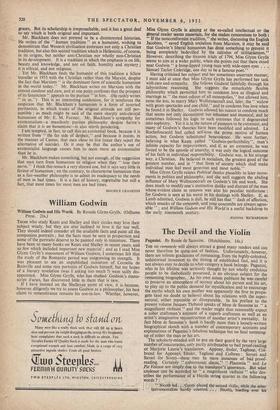The Devil and the Violin
Paganini. By Renee de Saussine. (Hutchinson. 16s.) Tim vie romancie will always attract a good many readers and can never therefore be quite out of fashion. Unfortunately,•however, there are infinite gradations of romancing, from the highly-coloured, unhistorical invention to the tinting of established fact, and it is not always easy to decide to what category a book belongs. Paganini, who in his lifetime was seriously thought by not wholly credulous people to be diabolically possessed, is an obvious subject for the romancing biographer. As his own astute publicist he was careful to preserve an atmosphere of secrecy about his person and his art, to play up to the public demand for mystification and to encourage the myths which his own mother was apparently the first to propa- gate (and no doubt to believe): about his relations with the super- natural, either reputable or disreputable. In his preface to the present volume Jacques Thibaud speaks of Mme de Saussine as " a magnificent violinist " and the reader might thus reasonably expect a sober craftsman's estimate of a superb craftsman as well as an artist's imaginative reconstruction of another artist's mentality. In fact Mme de Saussine's book is hardly more than a loosely-written biographical sketch with a number of contemporary accounts and explanations of Paganini's fabulous technique but no final summing- up of either the man or his art. The scholarly-minded will be put on their guard by the very large 'number of inaccuracies, only partly attributable to bad proof-reading or Marjorie Laurie's translation. Appony, Essler, Taglione, Col- brand for Apponyi, Elssler, Taglioni .and Colbran Savori and Savari for Sivori—these may be mere instances of bad proof- reading. Certainly " enharmonic diesis," " Placentia " and La Pie Voleuse are simply due to the translator's ignorance. But what 'credence can be accorded to " a magnificent violinist " who des- cribes the performance of a Haydn string quartet in the following words ? : ' "Nicola led . Qermi played the second violin, while the other instrumentalists hardly counted.... Nicolo, beading over his friend as if he were helping a child, was on edge with anxiety. When- ever Germi made a slip, be played loudly to cover it up. During the Adagio his.eyes were wet with tears.'
If this is drawn from a contemporary account, it must be that of an inquisitive housemaid. If—as is much more likely—it is an example of vie romancie, it is indeed hard to believe that the romancer is herself a violinist.
These major blemishes notwithstanding, the narrative of such a life as Paganini's can hardly fail to be of interest. The hypochondriac whose valet laughingly suggested that he had had as many doctors as Don Juan had Spanish mistresses, was himself irresistible to women. This musical Byron, whose concert-earnings foreshadowed Holly- wood, was accused of an avarice which was indulged at 'eat partly in order to provide for a beloved son. The initiator of modern transcendental violin technique indulged in tours de force such as would permanently disgrace a. serious artist of the present day, yet his playing could. inspire Schumann, Liszt and Berlioz. This bundle of contradictions deserves a more profound psychological study than Mme de Saussine has accorded him ; but meanwhile her book will make easy reading for any curious musician faced with a long journey and not too demanding in the matter of style or presentation.
MARTIN COOPER.



































 Previous page
Previous page